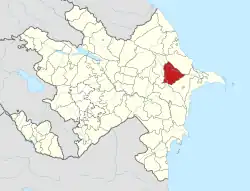Gobustan District | |
|---|---|
 Map of Azerbaijan showing Gobustan District | |
| Country | |
| Region | Mountainous Shirvan |
| Established | 24 April 1990 |
| Capital | Gobustan |
| Settlements[1] | 33 |
| Government | |
| • Governor | Adil Mammadov |
| Area | |
| • Total | 1,370 km2 (530 sq mi) |
| Population | |
| • Total | 47,400 |
| • Density | 35/km2 (90/sq mi) |
| Time zone | UTC+4 (AZT) |
| Postal code | 3700 |
| Website | qobustan-ih |
Gobustan District (Azerbaijani: Qobustan rayonu) is one of the 66 districts of Azerbaijan. It is located in the east of the country and belongs to the Mountainous Shirvan Economic Region. The district borders the districts of Shamakhi, Khizi, Absheron, and Hajigabul.[3] Its capital and largest city is Gobustan. As of 2020, the district had a population of 47,400.[2]
History
The name "Gobustan" originated from the word "Gobu", which means "beam" in Azerbaijani.[4] The district's administrative centre, Gobustan was known as Maraza until 2009.
The territory of the district belonged to the neighbouring Shamakhi District from 1930 until 1943 and later again from 1960 until 1990 when it was re-established.
The ancient dwellings used to be in the area of present Gobustan which date back to the Stone Age.[4]
Infrastructure
There are six kindergartens in the region, and 30 general education schools. There are 23 cultural centers, 3 hospitals and medical enterprises, and 6 big and middle enterprises.[3]
Population
According to official statistics the district of Gobustan had a population of 46,100,000 inhabitants at the beginning of 2018; 36,700,000 of whom were living in rural areas.[5]
| Population | 2010 | 2011 | 2012 | 2013 | 2014 | 2015 | 2016 | 2017 | 2018 | 2019 | 2020 | 2021 |
|---|---|---|---|---|---|---|---|---|---|---|---|---|
| Gobustan region | 40.5 | 41.1 | 41.8 | 42.5 | 43.2 | 44.0 | 44.8 | 45.4 | 46.1 | 46.7 | 47.4 | 47.9 |
| urban areas | 8.2 | 8.3 | 8.5 | 8.6 | 8.8 | 9.0 | 9.1 | 9.3 | 9.4 | 9.5 | 9.7 | 9.8 |
| rural areas | 32.3 | 32.8 | 33.3 | 33.9 | 34.4 | 35.0 | 35.7 | 36.1 | 36.7 | 37.2 | 37.7 | 38.1 |
Geography
Landscape
The territory of Gobustan ranges from the shores of the Caspian Sea to Mount Gijaki, the highest point in the eastern part of the Greater Caucasus. Peculiarities of Gobustan landscape are the rocks of lime and sandstone in the middle territory of the district, and mud volcanoes, which are located in the east part of Gobustan.[6]
Climate
Gobustan has a semi-arid climate, with mild winters and hot summers. There are rain seasons in early spring and late autumn. The annual precipitation is 250 mm. The western part of Gobustan is more precipitated in autumn and spring than the eastern part of Gobustan since Kura lowlands cover the western part. The highest mean temperature is observed in July (32 C) and the lowest mean temperature occurs in January (-1.6 C).[6]
Flora
Gobustan has a rich flora with 470 different plant species; in all of Azerbaijan there are 4000 different plant species. The vegetation of Gobustan has desert and semi-desert characteristics. Wild rose, Hibernian honeysuckle, wild pear, wild pomegranate, wild fig, and juniper can be found in Gobustan.[7]
Fauna
There are approximately 110 wild bird species in the Gobustan region. 53 of them are included in special European conversation concern, 9 of them are included in the Azerbaijan Red Data Book, and 9 of them are listed by the International Union for Conversation of Nature (IUNC).[6]
There are 28 different mammal species in Gobustan. Two of them are included in the Azerbaijan Red Book, and one species is listed in the IUCN.[6] There are two different types of amphibians and 20 different species of reptiles. Testudo greaca is included in the Red Book Data of Azerbaijan and IUCN.[7]
Economy
Agriculture
Agriculture is the core of the Gobustan economy. The most important agricultural product in the region is grain. The annual production of grain is approximately 1 ton per person.[8] Other major agricultural products are potato, cabbage, tomato, grape, pea, sunflower, and melon.[3]
Court
Gobustan District Court was established in 1990; it is called Gobustan District People's Court and is subordinate to the Ministry of Justice of Azerbaijan SSR.[9]
References
- ↑ "İnzibati-ərazi vahidləri" (PDF). preslib.az. Retrieved 28 February 2021.
- 1 2 "Population of Azerbaijan". stat.gov.az. State Statistics Committee. Retrieved 22 February 2021.
- 1 2 3 "Information on the administrative-territorial units". azerbaijan.az. Archived from the original on 2019-01-17. Retrieved 2018-09-06.
- 1 2 "Ganja Regional Culture and Tourism Department". regex.mctgov.az. Retrieved 2018-09-06.
- ↑ Samadov, Anar. "Population | The State Statistical Committee of the Republic of Azerbaijan". The State Statistical Committee of the Republic of Azerbaijan. Retrieved 2018-09-06.
- 1 2 3 4 Schmidt, Sebastian (2009). Potential Analysis for Further Nature Conservation in Azerbaijan: A Spatial and Political Investment Strategy. Greifswald: Geozon Science Media. ISBN 3941971018.
- 1 2 Permanent Delegation of the Republic of Azerbaijan to UNESCO. "Gobustan". unesco.mfa.gov.az. Retrieved 2018-09-07.
- ↑ "Rayon haqqında - QOBUSTAN RAYON Icra Hakimiyyəti". qobustan-ih.gov.az (in Azerbaijani). Retrieved 2018-09-07.
- ↑ "Gobustan District Court".